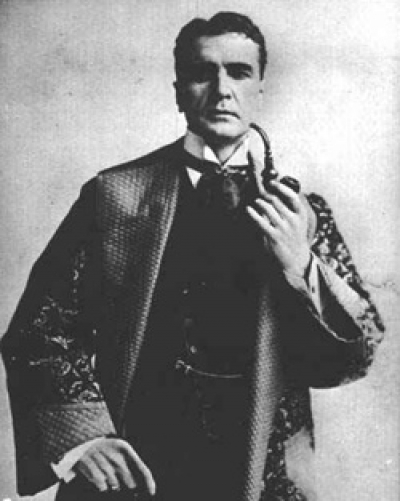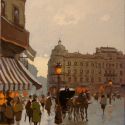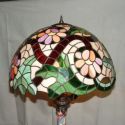
photo: http://www.nndb.com/people/736/000090466/gillette-sm.jpg
Biography William Gillette
William Gillette
Youth
The town were William Gillette was born, Nook Farm (Hartford, Connecticut), was a literary and intellectual node, abiding Mark Twain and Harriet Beecher Stowe. His father was the wealthy Francis Gillette, former USA-Senator with conservative and reformist ideas --fighting for abolition, modals and public education--, who constructed most of town's infrastructure. His mother was Elisabeth Daggett Hooker, descendant of Thomas Hooker --puritan leader, who founded the town--. In the mansion, Gillette grew up with his 5 brothers.
As student, William Gillette featured in oratory, acting and engineering. But Mark Twain, close neighbor, pushed him towards the acting career --that became his real vocation--. His last year of regular student was 1873 (20 years old), then working in a stock company of New Orleans briefly. But, after own Mark Twain's recommendation, he debuted at the Globe Theater of Boston with Twain's stage-play Guilded Age, in 1875. Afterward, Gillette was stock actor for six flopping years through Boston, New York and the Midwest.
For some time, William Gillette assisted irregularly to a spate of institutions, albeit never completing: Trinity, Harvard, Yale (1875), Massachusetts Institute of Technology, NYC-College and Boston University. After unfruitful warnings, his relentless family, expecting in vain he could accomplish any degree of conservative bent as his father did, disinherited him.
Playwright, director and actor
In 1881, while performing at Cincinnati, William Gillette was hired as playwright, director and actor, by Gustave and Daniel Frohman. Taken to New York with a salary of $50-week, his first play was The Professor. He debuted in the Madison Square Theater, lasting 151 performances, with a posterior tour through many States (far as St. Louis). That same year, he performed his consecrating piece Esmeralda, written together with Hodgson Burnett.
Overlooking the critic always, William Gillette strove to fill all theater's seats. Committed to catch the spectator by sprightly effects and many improvements on sound system, stage and illumination --i.e. sudden blackouts for dramatization, fade-in/fade-out at scenes' beginning, etc.--. Often, he added large pantomime segments, that were effective on the audience also.
Usually leaning in cold roles enduring extreme situations, Gillette was also regarded as the "aristocrat of the stage" and an innovator in interpretation. His acute realism was accented by his particular charisma, replacing much dialog with physical action also. Something he denominated "The Illusion of the First Time in Acting", as mentioned to the American Academy of Arts and Letters (1913).
Indeed, historians have noted that he did "natural acting and not the melodramatic declaiming, proper of the 1800s". In other words, Gillette was an artist based on his personality.
Being considered that all Gillette's traits had historical consequences, since American theater began to reach out the common people.
Sherlock Holmes casting
Charles Frohman was a young Broadway producer, successful with the exchanging of theater productions between USA and UK. After he produced some Gillette's plays, they definitely adjoined later on. Their productions had great success, sweeping Gillette into London's society spot --historically reluctant to American theater--.
In 1897, William Gillette performed his Secret Service at Adelphi Theater of London, with great success and praised by the critic also. Significant event, particularly because he was spotted by Sir Arthur Conan Doyle then.
Conan Doyle had finished his Sherlock Holmes saga with The Final Problem --published in 1893, with a deadly falling to Reichenbach's abyss together with Moriarty, his nemesis--. Then, he was needed monetarily, planning to build a new house. He decided to take his character to stage then. While two previous plays had been done by Charles Brookifield --skit "Under the clock", 1893-- and John Webb --"Sherlock Holmes", 1894--, Doyle wrote a new 5-act play nevertheless, with Holmes and Moriarty in their freshmen years as detectives.
After attending Gillette's London presentation of 1897, Conan Doyle commented to the press that was his favorite actor to perform the classic sleuth. He contacted Frohman then --who was in Broadway--. But Conan Doyle canceled the deal when Frohman pretended to own the staging-copyright also.
Conan Doyle offered the production to Henry Irving and Beerhom Tree then. But when they demanded to readapt Holmes to their acting profile, he turned down the deal, considering that this would debase the character.
Noting that Conan Doyle was hopeless and weighing that Gillette could do it, the literary agent A. P. Watt sent again the script to Frohman. Frohman, assessing that this was impossible, traveled to London to meet Conan Doyle nonetheless. There, Frohman suggested the prospect of an adaptation by William Gillette. Conan Doyle endorsed this and Frohman obtained the staging-copyright (1897).
William Gillette, who read the entire collection for first time then, liked the idea and started the piece's outlining in San Francisco, while touring with Secret Service still. Both artists became confident. In one occasion, Gillette referred by telegraph: "May I marry Holmes?" . The unwavering Conan Doyle's responded: "You can marry him, or kill him. Or anything you want."
Oh, this is elementary, my dear Watson
William Gillette's version consisted of 4 acts. Epitomizing several Conan Doyle's stories, he mainly grasped of "A Scandal in Bohemia" and "The Final Problem". Also, it had elements from "Study in Scarlet", "The Sign of the Four", "The Boscombe Valley" and "The Greek Interpreter".
Different to the only-intellectual original --"a machine rather than a man"--, William Gillette portrayed Sherlock Holmes as brave and open to express his feelings; introducing the deerstalker cap --originally featured by Sidney Paget in the 1890s--, the cloak and the curved pipe --instead the straight one, so Gillette, a great smoker also, could pronounce his lines--. While he used too: the magnifying-glass, the violin and the syringe.
Gillette formulated the complete phrase: "Oh, this is elementary, my dear Watson" --used by Clive Brook later, first spoken-cinema Holmes, as: "Elementary, my dear Watson"--, one of Holmes' well known traits.
Irene Adler, the woman of the series, was replaced by Alice Faulkner, young and beautiful lady who was planning to revenge her sister's murder but eventually falls in love with Holmes.
The tentative title was: "Sherlock Holmes in an Unknown Episode, not Published in the Great Detective's Career, showing his connection with the Weird Ms. Faulkner case". But it was reduced later to: "Sherlock Holmes - A Drama in Four Acts."
After Baldwin Hotel 's blaze in San Francisco --November 1898--, both original scripts, Conan Doyle's and Gillette's adaptation, were destroyed. Gillette wrote the piece again nevertheless, in a month and by memory.
Traveling in 1899 to present it to Conan Doyle, they met in Ulster's train station. Gillette showed up disguised as Sherlock Holmes. With character's posing, he approached slowly and said: "You're the writer, no doubt about it". Conan Doyle approved the script and both became friends.
The tour
Original tour's poster. "Presented by Charles Frohman."
After a pre-debut presentation streak since October 1899 --Buffalo, Rochester, Syracuse, Scranton and Wilkes-Barre--, Sherlock Holmes debuted in the Garrick Theater of New York in November 6, 1899, performing until June 16, 1900. It was an instant success. Gillette applied all his dazzling special effects over the massive audience.
But he faced sharp, even derisive, criticism from the newspapers, specially about Holmes falling in love --in the novels he had "aversion to women"--. As a matter of fact, throughout 34 years, they would rarely praise the production.
Also, the company toured nationally, along the western states --October 8, 1900, to March 30, 1901--; bolstered by other company also, with Cuyler Hastings, through minor cities and Australia.
After a pre-debut week in Liverpool, the company debuted in London (September 9, 1901), at the Lyceum Theater, performing in Duke of York's Theater later.
It was another hit of audience, despite not convincing the critic. The 12 weeks originally appointed were at full-hall. The production was extended until April 12, 1902 (256 presentations), including a gala for King Edward VII, in February 1. Then, it toured through the British Islands, with two ancillary groups: north (H.A. Saintsbury) and south (Julian Royce).
While were being produced many other versions already in foreign countries (i.e. Australia, Sweden, South Africa), back in USA, Gillette toured again from 1902 to 1903. Until November of 1903, when Gillette launched his next play: The Admirable Crichton, requested personally by its author, J.M. Barrie.
World famous actor
One of the many caricatures. This one belongs to Vanity's fair.
In his life, Gillette represented the piece up to 1,300 times (third in the historical stage-record), before American and English audiences. Widely, he appeared in many magazines, by photographs or caricatures. Even, he was in theater programs' covering.
Meanwhile, all around the world, other productions swarmed, based on Gillette's Sherlock Holmes, either satiric --very successful-- and/or undue; some lasting along several seasons even. Frohman's lawyers tried to curb the illegal phenomenon exhaustedly, traveling overseas, from court to court.
Even Gillette parodied Holmes once and, ironically, in this occasion the critic praised the production. The Fearfully, The Harrowing (1905) was an one-act piece, preamble to the main production, conceived as homage to Joseph Jefferson Holland --member of the company who had passed away while touring--. It was about Holmes, with his typical pose but not uttering a word, listening an alienated woman calmly. Gillette repeated the piece in London, promoting his sentimental drama Clarice (September-October 1905). The juvenile Charles Chaplin was Billy the pageboy there. But, since this production was a failure, he replaced Clarice with Sherlock Holmes. Chaplin repeated his role again.
Holmes' portrait
The magazines Collier's Weekly (USA) and The Strand (UK) pushed Conan Doyle avidly, offering to continue Sherlock Holmes series for a generous paying. The new chapters were published since 1901, first with a prequel and later with Holmes revived definitively (1903). It continued for another quarter-century.
Gillette's posing pictures by the artist Frederic Dorr Steele were featured in Collier's Weekly 's covers then and reproduced by all American media. Additionally, Steele contributed with Conan Doyle's book-covers, Gillette's short stories (Baker Street Irregulars) and, later, doing marketing when Gillette's farewell performances.
As international copyright didn't exist yet, Conan Doyle's series were widely printed throughout USA, mostly with pictures of William Gillette on-stage. P. F. Collier & Son owned the copyrights of Steel's illustrations and issued drawings in many editions.
Gillette's castle
Gillette's Castle in Hadlyme (Connecticut)
Gillette announced his retirement many times along his career, despite not accomplishing this until his death almost. The first of those took place in 1919, purchasing the boat Aunt Polly then ---of 144 feet and 200 ton--.
In 1912, while sailing the Connecticut river, Gillette spotted a hill, part of the Seven Sisters, over a ferry's pier in Hadlyme. He docked, disembarked and climbed up. He was so amazed by the view that purchased 115 acres of land, the next month. He decided to build up a castle based on a Norman fortress (Robert the Devil).
Along the ongoing five years of completion, Gillette was living in the Aunt Polly. The material was carried up by an aerial-trolley designed by him. The Castle's walls were 5-feet --base-- to 3-feet wide --upper levels--; possessing 24 rooms and 47 doors, with puzzled hand-carved locks --devised by Gillette also--. The main salon sized 30 by 50 feet and 19 feet of height, featuring a complexly mirrored system of surveillance that ended in his bedroom --"to make great entrances in the opportune moment", as Gillette explained--.
The mansion was finished in 1919, costing 1 million dollars. Gillette called it Seven Sisters. Its small train was his personal pride, 3 miles-long, all around the property. He enjoyed to stroll on it in company of his guests --Albert Einstein was one of them--.
Farewell tour
An elder William Gillette with full Holmes's costume
Naturally, Sherlock Holmes was Gillette's foremost production with 1,300 representations (1905, 1906, 1910, 1915 and 1923). While performing other tours, he was always forced to include at least one extra-representation of Sherlock Holmes, by popular demand.
In 1929 (66) Gillette started the farewell tour of Sherlock Holmes, in Springfield, Massachusetts. Scheduled for two seasons, it was extended to 1932 instead.
In the New Amsterdam Theater of New York --November 25, 1929--, a great ceremony took place. Gillette received a sign-book by 60 world-eminences. There, in his speech, Conan Doyle stated: "I consider the production a personal gratification... My only complain is that you made the poor hero of the anemic printed page a very limp object as compared with the glamour of your own personality which you infuse into his stage presentment." Former President Calvin Coolidge commented that the reposition was a "public service". While, at last, the critic coincided for good, praising it sentimentally. The definitive stage-bye took place in March 19, 1932, in Wilmington, Delaware.
Last years
Gillette died in April 29, 1937, in Hartford, because a pulmonary hemorrhage. He was buried in Hooker's family cemetery, at Farmington, Hartford Country, Connecticut.
Trivia
Around June 1903, in one of the shadow companies touring UK, Charles Chaplin (12 years old) was hired to play Billy the pageboy. He was saved from impoverishment then. Repeatedly, years later, at his heyday, Chaplin touched on this anecdote beholdenly when interviewed.
Orson Welles did an homage adaptation of Gillette's Sherlock Holmes, imitating Gillette's style, in his The Mercury Theater on the Air (September 25, 1938). "It is not enough to say that William Gillette resembles Sherlock Holmes; Sherlock Holmes looks exactly like William Gillette." (Welles)
Gillette was married 6 years, until his wife died. He was very depressed by 5 years and never married again. But later, he was regarded as philanderer since many women passed by his castle. He mailed with one of them particularly, by decades.
After Gillette assisted, in New York, to a reunion of The Baker Street Irregulars --December 7, 1934--, the place became Gillette Memorial Luncheon. It's leased in the same date annually, to celebrate Sherlock Holmes birthday, by Baker-Street... 's fellows.
Gillette's Sherlock Holmes was the first radio-drama transmitted in stereo in UK --November 15, 1958--. It was adapted by Raymond Raikes.
Gillette had the same butler for 30 years, hired in 1890: Yukitaki Ozaki was a political refugee from Japan. Member of a rich family, Yukitaki was embarrassed in one occasion at his humble job, because they were about to visit the castle. Gillette switched the roles, doing him of butler and Yukitaki of his master. Ozaki was replaced by another Japanese butler, Fakumatsu Tsubone.
Gillette improved Aunt Polly 's interior, upholding it by years. But the boat sunk later. Its remains are exhibited inside Gillette's Castle.
Another Gillette's big fondness was his motorcycle. He used to drive it around the castle. Once, he lost the braking and dived into the river. His attempt to quickly rescue the vehicle had to be barred by some onlookers.
Once, Gillette was urged by taxation and his castle could be forfeited. So, he decided to burn a yacht recently purchased, fifty yards from Hadlyme's pier.
Gillette supported Governor Wilbur Cross, advising him on political strategies also.
Visiting Washington D.C., Gillette was invited to the White House.
The studious journalist Henry Zecher is deemed as one of "World's foremost authorities on William Gillette".
Plays
In his life, Gillette wrote 13 original plays, 7 adaptations an some collaborations, encompassing farce, melodrama and novel adapting. Two pieces about the Civil War highlights: Held by the Enemy (1886) and Secret Service (1896). Particularly, Secret Service was successful with both the public and the praising critics. He reaped 3 million dollars in gaining, great deal of it by copyright.
1881, The Professor. Original. Gillette's first play. About an appealing professor coveted by the girls, while grappling with the rude boys.
1881, Esmeralda. Adaptation (original by Frances Hodgson Burnett). Light comedy. Starred by Annie Russell. Later by Viola Allen. (Film: 1915)
1884, The Private Secretary. Adapted from the German Der Bibliothekar (by Gustav Von Moser). Well Known. Many changes over the original: Rev. Mr. Spaulding became a medium. Also, it had several modifications throughout five years of presentations.
1886, Held by the Enemy. Original. Successful. First Gillette's drama in years of the American Civil War. (Film: 1920)
1894, Too Much Johnson. Original. Successful. (Films: 1919, 1938)
1896, Secret Service. Original. Foremost production until Sherlock Holmes. On Civil-War 's Captain Thorne, Union-spy infiltrated as press correspondent (Lewis Dumont). Performed by Maurice Barrymore (Philadelphia) and William Gillette (Broadway). It lasted a year on stage. (Films: 1919, 1931, 1977 TV)
1899, She Loved him So. Original.
1899, Sherlock Holmes. (Films: 1916, 1922 UK, 1932, 1939 UK, 1981 TV, 1982 TV)
She (Fire Goddess). Adaptation (H.R.Ridder Haggard).
1903, The Admirable Crichton. First Gillettes's starring role in a play by James M. Barrie.
1906, Clarice. Original. Sentimental comedy.
1910, Electricity. Original.
1918, Dear Brutus. Second Gillette's starring role in a play by James M. Barrie. It included a young Helen Hayes.
In-life editions of Sherlock Holmes
1922. First publication by Samuel French. It was based in 1923's reposition.
1935. Published by Doubleday, Doran & Co.. It was a pricey edition, containing Gillette's foreword, multi-paged feature on trivial data and illustrations by Frederic Dorr Steele.
Filmography
The Battle at Fort Laramie (1913). Starring.
The Delayed Special (1914). Starring.
In 1916, Gillette starred the first cinema-adaptation of his Sherlock Holmes. Albeit it wasn't the first movie about Holmes. It was a seven-roll silent movie by Essenay Film Manufacturing Co.. Marjorie Kay played Alice Faulkner and Ernest Manpani was Moriarty. The acid critic noted that Gillette was "about to lose his physical strength to perform the character" since then, insisting that he would not be able to repeat it over the 60 years old. No copy of the film has survived.
In 1922, Goldwyn Pictures filmed another version of Gillette's play. It was directed by Albert Parker and John Barrymore played Holmes.
Secret Service. 1931. Radio Pictures. 69 minutes. Romantic drama in Civil War. It was directed by J. Walter Ruben and Richard Dix was the Union's spy.
Radio
In October 20, 1930, Gillette performed the first radio-version of Holmes in history: The Adventure of the Speckled Band. It was an original theater version by Conan Doyle, re-adapted by Edith Meiser. It was transmitted by WEAF-NBC (New York) and sponsored by G. Washington Coffe Co.. It was the pilot of a series actually, performed by several actors along five seasons.
In November 18, 1935, Gillette (80 years old) performed his own Sherlock Holmes in the WABC radio of New York, re-adapted by Edith Meiser; with Reginald Mason --Watson-- and Charles Bryant --Moriarty--. It's duration was 50 minutes. It was the pilot for a new Holme's series by Lux Radio Theater. New York Times said that Gillette was "still the best, with all his shades and improvisation".
As novelist
William Gillette wrote two novels.
1937, The Astounding Crime on Torrington Road. Only mystery novel.
Homage institutions
Tryon, North Carolina
In 1890, after his first visiting of Tryon, North Carolina, Gillette built the first of his two residences there. Nowadays, in November, is celebrated the William Gillette Festival, around the still surviving house, with personal items on display and souvenir selling.
Tryon's Festival home (External Link)
Gillette's Castle
After Gillette passed away, his will appointed to preclude for his castle any "blithering sap-head who has no conception of where he is or with what surrounded". In 1943, Connecticut's government took the property, re-baptizing it Gillette's Castle and Gillette Castle State Park.
Located in 67 River Road, East Haddam, Connecticut, it was reopened in 2002. After a four years of restoration --costing 11 million dollars--, It includes museum, park and many theatrical celebrations. It receives 100,000 annual visitors, who can do hikes or picnic.
Gillette´s Castle at Connecticut (External Link)
Quotes
“I want to make money on Holmes quick, so as to be through with it!”
“What good is a friend if you can't make an enemy of him?”
References
"Sherlock Holmes: The Published Apocrypha", compiled by Jack Tracy.
"The Final Adventures of Sherlock Holmes", compiled by Peter Haining.

































